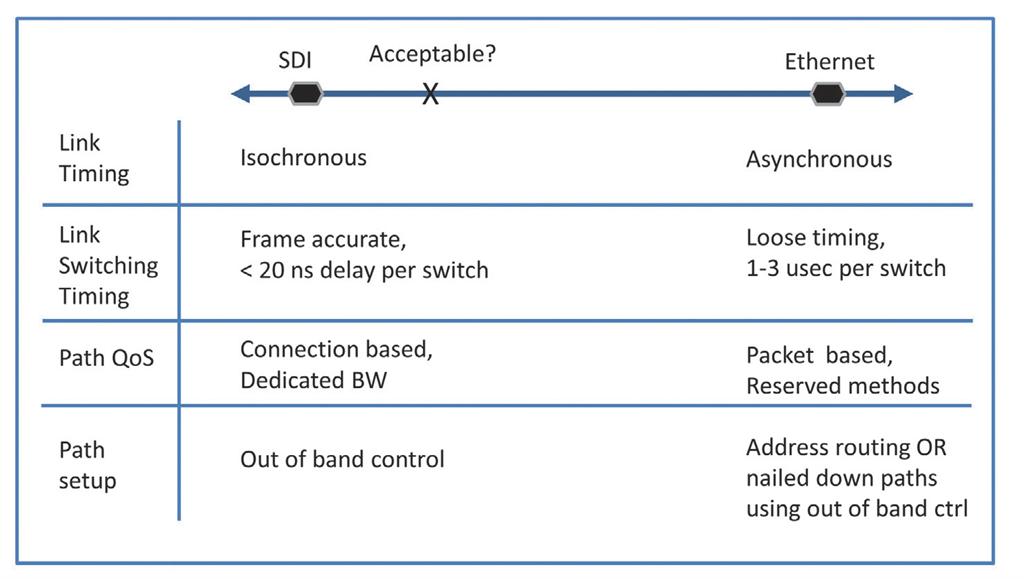Real-Time AV Transport Over Ethernet

Al Kovalick
The SMPTE-defined Serial Digital Interface, and the switching ecosystem surrounding it, is the king of video transport technology in the media facility. Whether installed as 0.27, 1.5 or 3G links, no one doubts its universal dominance and ability to carry real-time AV signals.
It has several worthy traits that make it the ideal fit for AV transport. Key points to its success are: 1) lossless digital transport; 2) line and frame aligned data format; 3) frame-accurate switching system with point-to-multipoint outputs, and 4) an integrated control system for time aligned, switched path control.
However, SDI is falling behind the needs of new high-end production and cinematic workflows. With the advent of Ultra HD television formats, including 4K UHD (2160p) and 8K UHD (4320p), 3G SDI lacks the ability to carry these new streams. However, 6G, 12G and 24G SDI link rates could augment the existing family of links and support the new video formats. These do not exist today but could, in theory, be standardized by SMPTE over time. The new high-rate I/O ports would likely leverage Ethernet SFP+ and C-Form Factor Pluggable optical modules.
This does not mean that new SDI links will use Ethernet data packet framing, rather they will rely on Ethernet technology for the physical I/O ports. The on-the-wire modulation format may also borrow from Ethernet, but this has not been decided.
For the moment, let’s ignore the need for more speed. SDI is locked into a custom ecosystem that is not friendly to IT. SDI is not “routable” in the IP sense. It is a local link, not easily bridged to WANs and other long-distance transport. The SDI ecosystem includes link routers, path extenders, PCIe I/O cards and other SDI specific gear. Simply put, SDI runs counter to many of IT’s core values: commodity equipment, networkable, cloud-friendly and well understood by masses of technicians and engineers.
PRACTICAL SOLUTIONS

Fig. 1: Comparing SDI and Ethernet environments So, what can “replace” SDI? Ethernet and IP in tandem show the most promise. “But wait,” you say. “Packetized Ethernet is not video-friendly; it’s asynchronous and packets get dropped all the time. Ethernet will never replace SDI.”
True, these are real obstacles, but current study and advances show there are practical solutions to using Ethernet/IP to transport SDI payloads with near SDI equivalence. Ethernet currently offers a variety of rates including 100 Mbps, 1 Gbps, 10 Gbps, 40 Gbps and 100 Gbps. Whereas SDI I/O is an add-on to a data server, 10G Ethernet ports will be included on most servers’ motherboards.
Ethernet, which celebrated its 40th anniversary in May, started life as a humble 10 Mbps link. Researchers see no end in sight for higher rates. Ethernet’s substantial rate support is partially responsible for the bandwidth tsunami we see today. At its current pace, expect to see 400 Gbps Ethernet in 2017, 1 Tbps in 2024 and looking far ahead, 1 Pbps in 2053. Robert Metcalfe and his team are credited with inventing Ethernet. There is no stopping this train, so get onboard or get out of the way.
Fig. 1 compares SDI and Ethernet environments. Due to their intrinsic differences, Ethernet can’t exactly duplicate SDI. However, can Ethernet and its surrounding switching ecosystem be coerced to provide an acceptable solution, one that works for the majority of use cases?
This question is being answered on several fronts. From real-world tests we know that the total end-to-end latency, through several switches, in a facility environment can be less than one line of HD video (about 15 μsec).
We also know that switched paths can have lossless QoS using a variety of standard techniques and that replicated outputs are possible as on an SDI switch.
WORKING OUT THE DETAILS
There is accumulating evidence that commodity Ethernet switches can be used to switch AV streams frame accurately as done in an SDI router. Expect to see demos of this at the 2014 NAB Show. Sure, there are details to work out, but the signs are encouraging for an all-Ethernet facility being a real possibility.
The SDI data payload can be mapped onto Layer 2 (MAC) or Layer 3 (IP); this has been called SPoE for SDI Payload over Ethernet. There is wisdom to reusing the SMPTE SDI data payload format with embedded multichannel audio and complex metadata.
Let SMPTE continue to define the payload formats and let the IEEE evolve Ethernet; a perfect marriage. Mapping a 1.5G SDI payload onto a 10G link results in packing five separate SDI payload streams or 10 if the Ethernet is used bidirectionally (not possible with SDI).
This packing efficiency will reduce cabling and I/O ports. 10G Ethernet can be transported over long-distance optical fiber or CAT 6A cables with common RJ45 connectors and spanning 100 meters.
It’s worth noting, the IEEE has standardized Audio Video Bridging, a method to send time-stamped AV streams over L2/ MAC networks while maintaining lossless paths and end-point time sync for all signals. There are efforts in the works to do a SPoE mapping. AVB is not a direct SDI replacement, but it has several characteristics of merit.
In 2013 the Video Services Forum, SMPTE and the EBU (Geneva) formed the Joint Task Force for Networked Media. This cross-vendor and end-user group is motivated to sort out and resolve all the networking issues and submit their recommendations to standardization. They are collecting use cases for solutions that would, at a minimum, replicate the key traits of streaming SDI links using commodity networking gear.
This does not mean that SDI has no future. The transition to IT networking for AV streaming may take many years; expect a slow dissolve between technologies. Expect both Ethernet and SDI to coexist for some time.
Ethernet and its ecosystem have a bright future in the media facility. There is much work to be done before it will augment custom AV transports. Only the future will tell to what extent Ethernet will replace all traditional AV links or will stop at being just a subset. Stay tuned.
Al Kovalick is the founder of Media Systems consulting in Silicon Valley. He is the author of “Video Systems in an IT Environment (2nd ed).” He is a frequent speaker at industry events and a SMPTE Fellow. For a complete bio and contact information, visitwww.theAVITbook.com.
Get the TV Tech Newsletter
The professional video industry's #1 source for news, trends and product and tech information. Sign up below.

